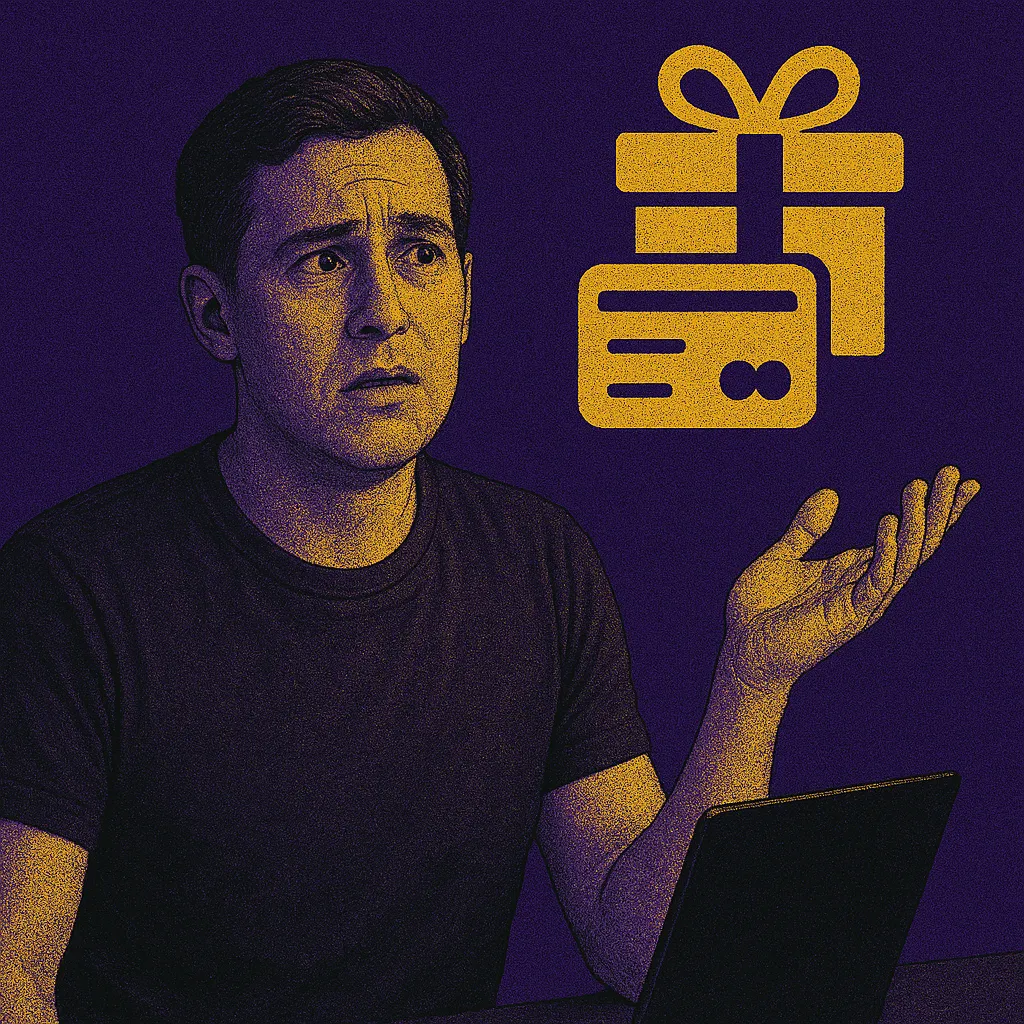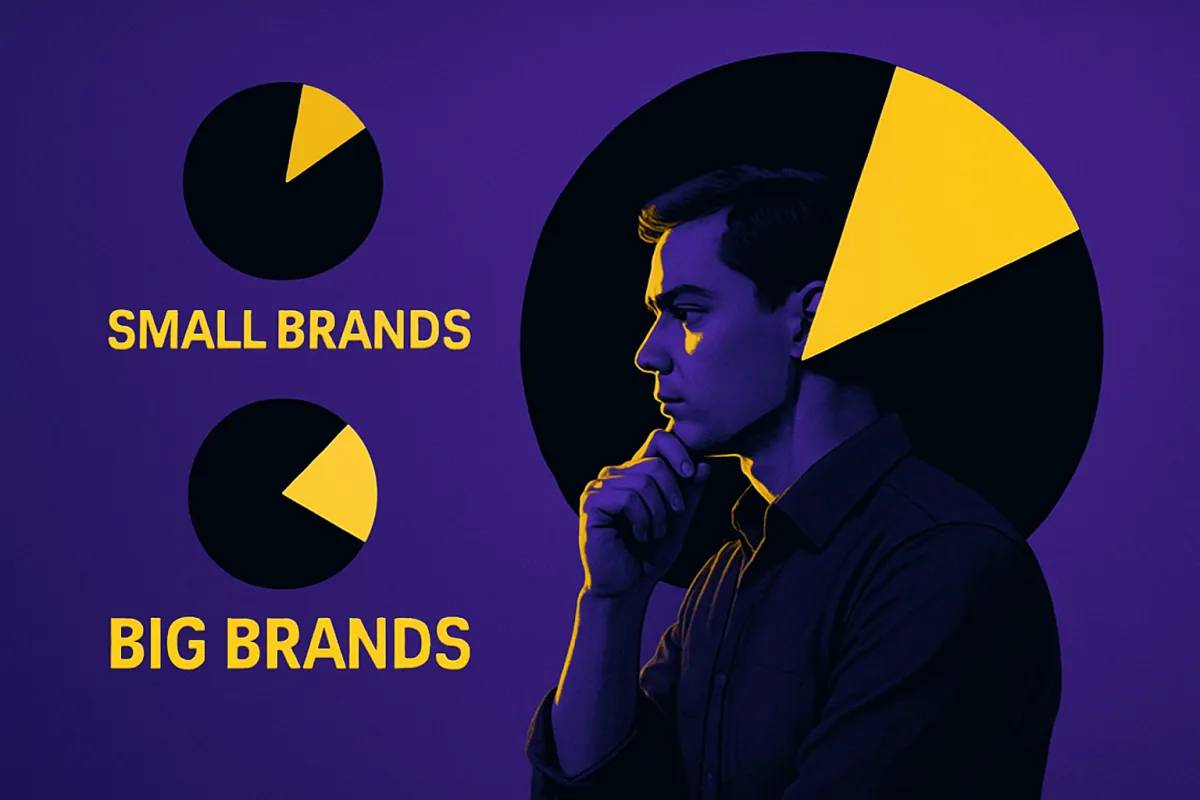By German Tirado, July 31, 2025
Table of Contents
Introduction: Loyalty Programs
Don’t Drive Growth—Market Share Does
Loyalty Programs: The Popular Myth
The Double Jeopardy Law Explained
Why Loyalty Is a Consequence, Not a Cause
What Bigger Brands Actually Do Differently
What Loyalty Programs Really Do (and Don’t)
The Growth Strategy That Works
Conclusion: Loyalty Comes From Reach
Frequently Asked Questions
Works Cited
Introduction: Loyalty Programs Don’t Drive Growth—Market Share Does

In the world of modern marketing, few ideas are as widely accepted, and misunderstood, as the notion that loyalty programs drive customer loyalty. From points systems in retail to tiered perks in SaaS, brands pour millions into schemes designed to retain customers. The logic seems sound: if you reward repeat buyers, they’ll come back more often, right?
Unfortunately, the data tells a very different story.
Over the past two decades, evidence from the Ehrenberg-Bass Institute for Marketing Science has upended many assumptions about how brands grow. One of the most well-established findings, known as the Double Jeopardy Law, reveals that loyalty is not built through loyalty programs or emotional connections. Instead, customer loyalty is a byproduct of brand size. In other words, brands with higher market share automatically enjoy higher levels of loyalty, while smaller brands struggle with both fewer buyers and less repeat purchasing [HBG1].
This is a profound shift in perspective. It means that the real path to increasing customer loyalty isn’t retention, it’s acquisition. The more customers a brand attracts, the more it will be bought again. Loyalty, in this view, is not something brands engineer through gamification or CRM automation, it’s something that emerges naturally from broader reach, stronger mental availability, and superior physical availability.
Yet many marketing teams continue to pour time, budget, and faith into loyalty marketing, under the mistaken belief that it will fuel long-term growth. They focus on deepening relationships with their existing customer base, even though most revenue comes from light and occasional buyers, and even though most customer churn is unavoidable and driven by external factors [BBBH].
In this article, we’ll examine why customer loyalty is tied to market share, not loyalty programs. We’ll walk through the scientific evidence, explain the implications for brand growth strategies, and show you why broad reach, penetration, and mental availability are far more powerful than any points-based program.
Whether you're in retail, B2B, subscription services, or CPG, this guide will help you shift your focus from loyalty illusions to loyalty outcomes, and show you how to achieve real, scalable brand growth using evidence-based marketing principles.
1. Loyalty Programs: The Popular Myth

“Shouldn’t we reward our customers for being loyal?”
On the surface, loyalty programs seem logical. Airlines offer miles. Cafés offer punch cards. SaaS platforms provide tiered perks.
But in most cases, loyalty programs don't increase loyalty, they simply track it. They incentivize short-term behavior but do not create deep, sustainable commitment. And most importantly, they rarely attract new buyers, which is what drives growth.
The illusion: Loyalty programs build loyalty.
The reality: Loyalty programs mostly reward existing behavior.
Even in categories with high purchase frequency, such as supermarkets or gas stations, loyalty programs tend to shift share within a repertoire, not grow the category or brand itself [BBBH].
2. The Double Jeopardy Law Explained

The Double Jeopardy Law states that smaller brands are penalized twice:
They have fewer buyers (lower penetration).
Their buyers are less loyal (lower purchase frequency or higher defection).
This is not because the brand is “worse” or its customers are fickle. It’s a structural outcome of lower mental and physical availability [HBG1].
Loyalty is therefore largely predictable based on brand size. If you’re small, expect low repeat rates. If you grow, loyalty will improve automatically.
“Loyalty is not a lever for growth, it is an outcome of growth.” [HBG2]
4. What Bigger Brands Actually Do Differently

Big brands don’t win because of stronger loyalty schemes. They win because of:
Mental Availability: People think of them more often, in more situations.
Physical Availability: They’re easier to find, buy, and access.
Consistent Distinctive Assets: Logos, colors, sounds, and taglines that cut through noise [BDA].
They are remembered when people are hungry, busy, in a hurry, buying for someone else, shopping late, or looking for a quick win. In short, they win by being there, in memory and on shelf.
They also dominate more Category Entry Points (CEPs), the mental triggers that cause people to think of a brand (e.g. “late-night snack,” “trusted for big projects,” “safe with kids”) [CEP-B2B].
5. What Loyalty Programs Really Do (and Don’t)

Loyalty programs may serve operational or research functions:
Help with data collection (e.g. CRM enrichment)
Offer a retention nudge for heavy buyers
Create price perception traps (“I’m getting value”)
Enable targeted promotions
But what they don’t do is grow your base of light or non-buyers, who make up the majority of the market.
In most categories, 40–60% of customers in a year are one-time buyers [HBG1].
A loyalty program aimed at these buyers is like offering a gold watch to someone who barely remembers your name.
6. The Growth Strategy That Works

So what does grow brands?
Reach more people. Run broad-reach campaigns that hit the full category. Avoid narrow segmentation that ignores light buyers.
Build CEP memory links. Refresh your brand’s association with common buying situations regularly.
Make buying easy. Be in more stores, more formats, more channels, more geos.
Use Distinctive Assets fluently. Show your logo, colors, and brand cues early and often.
Avoid over-targeting loyalists. Most of them will keep buying without being nudged. Focus instead on being thought of and being findable.
As Jenni Romaniuk summarizes:
“If you want more loyalty, get more customers. That’s the only sustainable path.” [BBBH]
7. Conclusion: Loyalty Is the Outcome of Penetration,
Not Points
The belief that loyalty programs drive brand growth is one of the most persistent myths in marketing. It’s easy to see why, loyalty feels like a noble goal. It suggests deeper customer relationships, emotional connection, and long-term profitability. But the uncomfortable truth is this: customer loyalty is not something brands can manufacture through incentives or gamified experiences.
Loyalty is a structural byproduct of market share. Brands with larger customer bases naturally enjoy higher repeat purchase rates. This phenomenon is not anecdotal, it’s a replicated law of marketing science, observable across industries, countries, and business models [HBG1]. Small brands don’t suffer from a lack of brand love; they suffer from being less mentally and physically available to buyers.
If marketers want to grow brand loyalty, they must first grow the number of buyers. That means focusing on:
Increasing market penetration
Reaching light and non-buyers with broad-reach campaigns
Building mental availability by linking the brand to many diverse Category Entry Points (CEPs)
Improving physical availability across locations, platforms, pack sizes, and channels
Using Distinctive Assets fluently and consistently to enhance recall
Loyalty programs, by contrast, often function as distractions. They cater to your most loyal, heaviest buyers—the very people least in need of additional incentives. These programs seldom reach the 95% of buyers who are out-of-market right now and have minimal impact on long-term brand growth [95-5].
If your goal is to increase customer retention, understand that retention is largely governed by the same laws as acquisition. The best retention strategy is to continually fill the top of your funnel, because today’s first-time buyer is tomorrow’s repeat purchaser. Loyalty will follow, as a consequence, not a cause.
So before investing more budget into rewards platforms, cashback schemes, or CRM-based loyalty journeys, ask yourself:
Would this money be better spent getting more people to know about, think about, and try the brand?
Because in the end, the brands that grow are the ones that reach more people, in more buying situations, with more ease. Loyalty doesn’t build brands, brands build loyalty.
8. Frequently Asked Questions (FAQs)
Q1: Do loyalty programs increase customer loyalty?
Not in a meaningful, scalable way. Loyalty programs may slightly increase repeat purchase behavior among your most frequent customers, but they don’t drive long-term brand growth. Loyalty is primarily a function of market share, not incentives.
Q2: What is the Double Jeopardy Law in marketing?
The Double Jeopardy Law states that smaller brands suffer twice: they have fewer customers (lower penetration) and those customers are less loyal. Larger brands have more customers who buy more often. This is a law of buyer behavior, not a result of brand “relationship strength” [HBG1].
Q3: Are loyalty programs still worth using?
They can be useful for tactical or operational reasons, such as gathering first-party data or nudging heavy buyers to spend slightly more. But they should not be treated as a central growth engine. They complement a brand strategy; they do not drive it.
Q4: What actually drives customer loyalty?
More customers. That’s it. Loyalty is a natural consequence of brand penetration, built by expanding mental availability (being top of mind across many buying situations) and physical availability (being easy to buy in many places and formats) [HBG2] [BBBH].
Q5: Is it cheaper to retain customers than acquire new ones?
Not always. Retention efforts often target the already-loyal, while churn is mostly caused by life factors outside your control. What’s more cost-effective is reaching light buyers and non-buyers, the segment that holds the most growth potential [95-5].
Q6: How do I make my brand more mentally available?
By linking your brand to more Category Entry Points (CEPs), the cues people use when deciding what to buy. For example, “when I need something reliable,” “when I’m short on time,” or “when I’m buying for my boss” [CEP-B2B]. Advertising that consistently connects your brand to these cues builds mental availability.
Q7: What are the best alternatives to a loyalty program?
Run broad-reach advertising to increase penetration
Build and refresh memory structures around key buying situations
Improve distribution and shelf presence
Invest in Distinctive Assets like logos, colors, and taglines for fast recognition
Track mental availability metrics rather than just NPS or churn
9. Works cited
[HBG1] Sharp, Byron. How Brands Grow: What Marketers Don’t Know. Oxford University Press, 2010.
[HBG2] Romaniuk, Jenni, and Byron Sharp. How Brands Grow: Part 2. Oxford University Press, 2015.
[BBBH] Romaniuk, Jenni. Building Better Brand Health: A How-To Guide for Evidence-Based Marketers. Oxford University Press, 2023.
[BDA] Romaniuk, Jenni. Building Distinctive Brand Assets. Oxford University Press, 2018.
[CEP-B2B] Romaniuk, Jenni. Category Entry Points in a Business-to-Business (B2B) World. Ehrenberg-Bass Institute, 2021.
[Double Jeopardy B2B] Romaniuk, Jenni, Dawes, John, & Faghidno, Hamid. The Double Jeopardy Law in B2B Shows the Way to Grow. Ehrenberg-Bass Institute, 2019.
[95-5] LinkedIn B2B Institute & Ehrenberg-Bass Institute. Advertising Effectiveness and the 95-5 Rule: Most B2B Buyers Are Not in the Market Right Now, 2021.
[Scientific Laws of Marketing†L262-L284] Scientific Laws of Marketing with Prof. Byron Sharp (interview transcript), 2023
Address
Phone: 725-240-6870
Email : [email protected]
Address : 6440 Sky Pointe Dr. #140-341 Las Vegas, NV 89131
Artificial Intelligence
Marketing & Branding
Marketing & Branding
©2025 Max Digital Edge | All Rights Reserved
